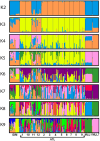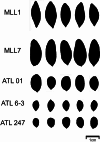Genetic and phenotypic evidence suggest the existence of indigenous olive population of wild var. sylvestris in the Carmel coast, southern Levant
- PMID: 39343909
- PMCID: PMC11441108
- DOI: 10.1186/s12870-024-05575-7
Genetic and phenotypic evidence suggest the existence of indigenous olive population of wild var. sylvestris in the Carmel coast, southern Levant
Abstract
Background: Populations of Olea europaea subsp. europaea var. sylvestris, the ancestor of cultivated olives, are scattered across the Mediterranean Basin. However, after millennia of possible hybridization with cultivated varieties, the genetic identity of many of these populations remain questionable. In the southern Levant, the plausible primary domestication center of olives, many of the naturally growing olive (NGOs) are considered feral, having developed from nearby olive groves. Here, we investigated the genetic identity of NGOs population in the Carmel region, hypothesizing that their specific location, which limit anemophily, provided an opportunity for the persistence of genuine var. sylvestris.
Results: We mapped more than 1,000 NGOs on the Kurkar ridge along the Carmel coast, within and outside the residential area of Atlit and used simple sequence repeats of 14 loci to assess the spatial genetic structure of 129 NGOs. Genetic diversity parameters and genetic distances between NGO and cultivated olives, as well as phenotypic and morphometric analyses of their oil content and pits, respectively, indicated the presence of a genuine var. sylvestris population. However, NGOs within the residential area of Atlit and old settlements showed an intermediate admix genetic structure, indicating on hybridization with local varieties, a consequence of their proximity to cultivated trees.
Conclusions: Integrating the results of genetic and phenotypic analyses we provide crucial evidence of the presence of a genuine var. sylvestris population in the southern Levant, in close geographical proximity to archaeological sites with the earliest evidence of olive exploitation in the ancient world. We supplement the results with recommendations for a conservation program that combines municipal requirements and the urgent need to preserve the largest population of var. sylvestris in the southern Levant.
Keywords: Olea europaea subsp. europaea var. sylvestris; Conservation; Genetic variation; Morphometry; Oil quality; Spatial structure.
© 2024. The Author(s).
Conflict of interest statement
The authors declare no competing interests.
Figures









Similar articles
-
Genomic evidence for recurrent genetic admixture during the domestication of Mediterranean olive trees (Olea europaea L.).BMC Biol. 2020 Oct 26;18(1):148. doi: 10.1186/s12915-020-00881-6. BMC Biol. 2020. PMID: 33100219 Free PMC article.
-
The history of olive cultivation in the southern Levant.Front Plant Sci. 2023 Feb 23;14:1131557. doi: 10.3389/fpls.2023.1131557. eCollection 2023. Front Plant Sci. 2023. PMID: 36909452 Free PMC article. Review.
-
Genetic variation of naturally growing olive trees in Israel: from abandoned groves to feral and wild?BMC Plant Biol. 2016 Dec 13;16(1):261. doi: 10.1186/s12870-016-0947-5. BMC Plant Biol. 2016. PMID: 27964727 Free PMC article.
-
Genetic Identification of the Wild Form of Olive (Olea Europaea var. Sylvestris) Using Allele-Specific Real-Time PCR.Foods. 2020 Apr 9;9(4):467. doi: 10.3390/foods9040467. Foods. 2020. PMID: 32283713 Free PMC article.
-
Current Status of Biodiversity Assessment and Conservation of Wild Olive (Olea europaea L. subsp. europaea var. sylvestris).Plants (Basel). 2022 Feb 10;11(4):480. doi: 10.3390/plants11040480. Plants (Basel). 2022. PMID: 35214813 Free PMC article. Review.
Cited by
-
Exploring drought tolerance in wild and traditional olive varieties from the Southern Levant.Front Plant Sci. 2025 Feb 12;16:1547174. doi: 10.3389/fpls.2025.1547174. eCollection 2025. Front Plant Sci. 2025. PMID: 40012732 Free PMC article.
References
-
- Van Zeist W, Bottema S. A palynological study of the Acheulian site of Gesher Benot Ya’aqov, Israel. Veg Hist Archaeobot. 2009;18:105–21.
-
- Finkelstein I, Langgut D. Climate, settlement history, and olive cultivation in the Iron Age Southern Levant. Bull Am Schools Orient Res. 2018;379:153–69.
-
- Langgut D, Almogi-Labin A, Bar-Matthews M, Weinstein-Evron M. Vegetation and climate changes in the South Eastern Mediterranean during the last glacial-interglacial cycle (86 ka): new marine pollen record. Q Sci Rev. 2011;30:3960–72.
-
- Schiebel V, Litt T. Holocene vegetation history of the southern Levant based on a pollen record from Lake Kinneret (Sea of Galilee), Israel. Veg Hist Archaeobot. 2018;27:577–90.
MeSH terms
LinkOut - more resources
Full Text Sources

